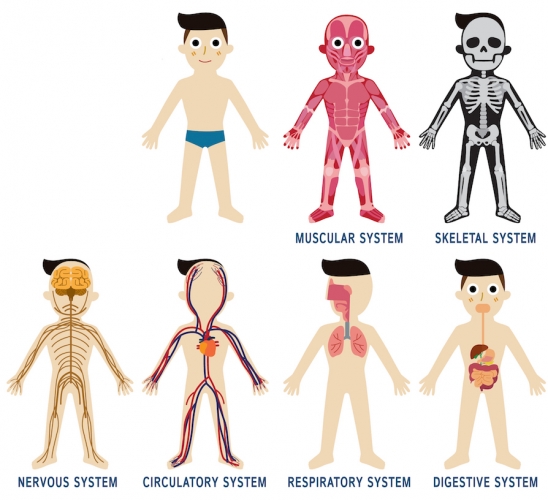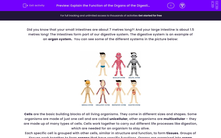Did you know that your small intestines are about 7 metres long?! And your large intestine is about 1.5 metres long! The intestines form part of our digestive system. The digestive system is an example of an organ system. You can see some of the different systems in the picture below:

Cells are the basic building blocks of all living organisms. They come in different sizes and shapes. Some organisms are made of just one cell and are called unicellular, other organisms are multicellular – they are made up of many types of cells. Cells work together to carry out different life processes like digestion, which are needed for an organism to stay alive.
Each specific cell is grouped with other cells, similar in structure and function, to form tissues. Groups of tissues work together to form organs that have specific functions. Organs are organised into organ systems, which work together to form organisms.

In the above diagram, the first image shows a leaf cell. The leaf cells group together to form a tissue, the tissues work together to form an organ - the leaf. The leaf and other organ systems work together to form the plant (an organism).
Organisation of the body allows complex organisms to carry out many different jobs at the same time.
The delicious burger and chips you ate for lunch have to be broken down in order for your body to use it. This breaking down of food is called digestion. The different organs that help with digestion are called the digestive system.
.jpg)
While chewing our food into smaller pieces, our food mixes in with our saliva. You wouldn’t think it, but our saliva is pretty special! Special because it makes your food moist and easy to swallow, but also it contains something called enzymes that help to break our food down.
Your burger and chips are now mashed up and swallowed. This moves down through the oesophagus (the pipe connecting your mouth to your stomach). The oesophagus has muscles that contract in a wave-like motion, which helps to push the food along and into your stomach.
In the stomach, the food is churned up, breaking it down even more. Here it mixes with a strong acid of pH 1 - 2. The acid is so strong that it's able to destroy microbes that might be present in the burger and chips you ate.
From the stomach, food enters the small intestine and the small digested food molecules are absorbed into the bloodstream. Sugars like glucose, and also vitamins and minerals, are soluble in water, so can pass through the wall of the small intestine. Larger insoluble molecules like starch, proteins and fats need to be broken up into smaller molecules by enzymes before they can be absorbed. Certain foods such as fibre we can’t digest.
The liver also helps with digestion. The liver makes a substance called bile which is released into the small intestine. The bile helps to cancel out (neutralise) stomach acid before it enters the small intestine. Bile also helps to break up fat into smaller droplets, allowing it to be digested quicker.
After the small intestine, the remains of the food travels to the large intestine. All that is left of the burger and chips now is water and waste material.
The water is valuable, so it’s absorbed from the large intestine into the bloodstream. The kidneys also help to make sure we have the right amount of water in our body.
The waste material can’t be digested or used by the body. The undigested waste travels to the rectum, where it is stored until leaving the body through the anus as faeces. Lovely!
In the following activity, you will explain the function of the different organs that make up the digestive system.








